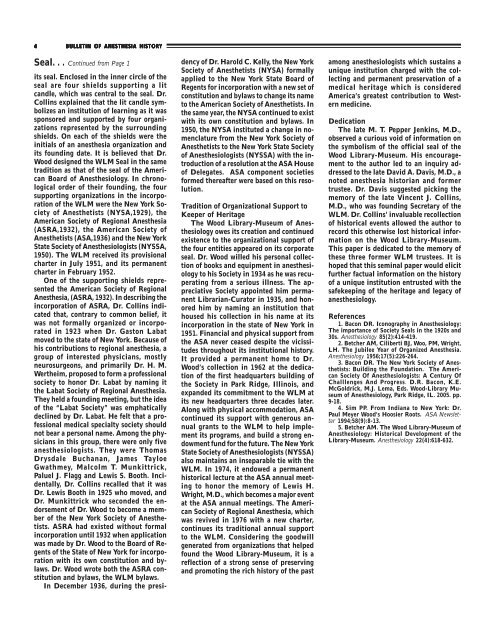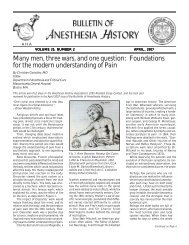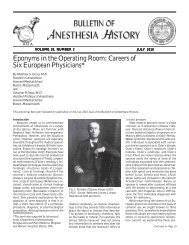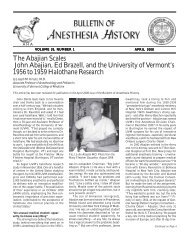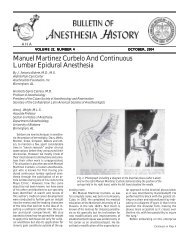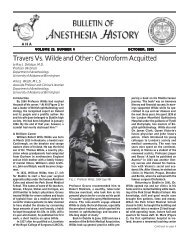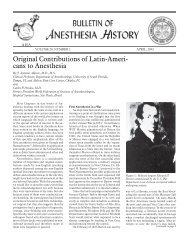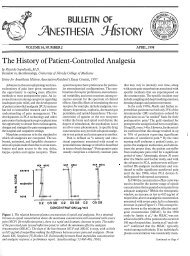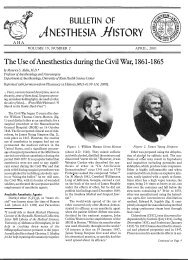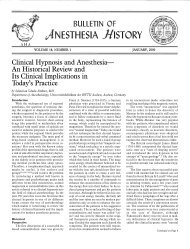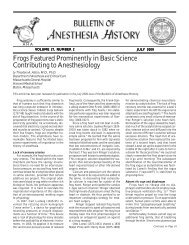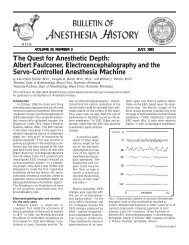January 2006, Vol 24 - Anesthesia History Association
January 2006, Vol 24 - Anesthesia History Association
January 2006, Vol 24 - Anesthesia History Association
Create successful ePaper yourself
Turn your PDF publications into a flip-book with our unique Google optimized e-Paper software.
4 BULLETIN OF ANESTHESIA HISTORY<br />
Seal. . . Continued from Page 1<br />
its seal. Enclosed in the inner circle of the<br />
seal are four shields supporting a lit<br />
candle, which was central to the seal. Dr.<br />
Collins explained that the lit candle symbolizes<br />
an institution of learning as it was<br />
sponsored and supported by four organizations<br />
represented by the surrounding<br />
shields. On each of the shields were the<br />
initials of an anesthesia organization and<br />
its founding date. It is believed that Dr.<br />
Wood designed the WLM Seal in the same<br />
tradition as that of the seal of the American<br />
Board of Anesthesiology. In chronological<br />
order of their founding, the four<br />
supporting organizations in the incorporation<br />
of the WLM were the New York Society<br />
of Anesthetists (NYSA,1929), the<br />
American Society of Regional <strong>Anesthesia</strong><br />
(ASRA,1932), the American Society of<br />
Anesthetists (ASA,1936) and the New York<br />
State Society of Anesthesiologists (NYSSA,<br />
1950). The WLM received its provisional<br />
charter in July 1951, and its permanent<br />
charter in February 1952.<br />
One of the supporting shields represented<br />
the American Society of Regional<br />
<strong>Anesthesia</strong>, (ASRA, 1932). In describing the<br />
incorporation of ASRA, Dr. Collins indicated<br />
that, contrary to common belief, it<br />
was not formally organized or incorporated<br />
in 1923 when Dr. Gaston Labat<br />
moved to the state of New York. Because of<br />
his contributions to regional anesthesia, a<br />
group of interested physicians, mostly<br />
neurosurgeons, and primarily Dr. H. M.<br />
Wertheim, proposed to form a professional<br />
society to honor Dr. Labat by naming it<br />
the Labat Society of Regional <strong>Anesthesia</strong>.<br />
They held a founding meeting, but the idea<br />
of the “Labat Society” was emphatically<br />
declined by Dr. Labat. He felt that a professional<br />
medical specialty society should<br />
not bear a personal name. Among the physicians<br />
in this group, there were only five<br />
anesthesiologists. They were Thomas<br />
Drysdale Buchanan, James Tayloe<br />
Gwathmey, Malcolm T. Munkittrick,<br />
Paluel J. Flagg and Lewis S. Booth. Incidentally,<br />
Dr. Collins recalled that it was<br />
Dr. Lewis Booth in 1925 who moved, and<br />
Dr. Munkittrick who seconded the endorsement<br />
of Dr. Wood to become a member<br />
of the New York Society of Anesthetists.<br />
ASRA had existed without formal<br />
incorporation until 1932 when application<br />
was made by Dr. Wood to the Board of Regents<br />
of the State of New York for incorporation<br />
with its own constitution and bylaws.<br />
Dr. Wood wrote both the ASRA constitution<br />
and bylaws, the WLM bylaws.<br />
In December 1936, during the presidency<br />
of Dr. Harold C. Kelly, the New York<br />
Society of Anesthetists (NYSA) formally<br />
applied to the New York State Board of<br />
Regents for incorporation with a new set of<br />
constitution and bylaws to change its name<br />
to the American Society of Anesthetists. In<br />
the same year, the NYSA continued to exist<br />
with its own constitution and bylaws. In<br />
1950, the NYSA instituted a change in nomenclature<br />
from the New York Society of<br />
Anesthetists to the New York State Society<br />
of Anesthesiologists (NYSSA) with the introduction<br />
of a resolution at the ASA House<br />
of Delegates. ASA component societies<br />
formed thereafter were based on this resolution.<br />
Tradition of Organizational Support to<br />
Keeper of Heritage<br />
The Wood Library-Museum of Anesthesiology<br />
owes its creation and continued<br />
existence to the organizational support of<br />
the four entities appeared on its corporate<br />
seal. Dr. Wood willed his personal collection<br />
of books and equipment in anesthesiology<br />
to his Society in 1934 as he was recuperating<br />
from a serious illness. The appreciative<br />
Society appointed him permanent<br />
Librarian-Curator in 1935, and honored<br />
him by naming an institution that<br />
housed his collection in his name at its<br />
incorporation in the state of New York in<br />
1951. Financial and physical support from<br />
the ASA never ceased despite the vicissitudes<br />
throughout its institutional history.<br />
It provided a permanent home to Dr.<br />
Wood’s collection in 1962 at the dedication<br />
of the first headquarters building of<br />
the Society in Park Ridge, Illinois, and<br />
expanded its commitment to the WLM at<br />
its new headquarters three decades later.<br />
Along with physical accommodation, ASA<br />
continued its support with generous annual<br />
grants to the WLM to help implement<br />
its programs, and build a strong endowment<br />
fund for the future. The New York<br />
State Society of Anesthesiologists (NYSSA)<br />
also maintains an inseparable tie with the<br />
WLM. In 1974, it endowed a permanent<br />
historical lecture at the ASA annual meeting<br />
to honor the memory of Lewis H.<br />
Wright, M.D., which becomes a major event<br />
at the ASA annual meetings. The American<br />
Society of Regional <strong>Anesthesia</strong>, which<br />
was revived in 1976 with a new charter,<br />
continues its traditional annual support<br />
to the WLM. Considering the goodwill<br />
generated from organizations that helped<br />
found the Wood Library-Museum, it is a<br />
reflection of a strong sense of preserving<br />
and promoting the rich history of the past<br />
among anesthesiologists which sustains a<br />
unique institution charged with the collecting<br />
and permanent preservation of a<br />
medical heritage which is considered<br />
America’s greatest contribution to Western<br />
medicine.<br />
Dedication<br />
The late M. T. Pepper Jenkins, M.D.,<br />
observed a curious void of information on<br />
the symbolism of the official seal of the<br />
Wood Library-Museum. His encouragement<br />
to the author led to an inquiry addressed<br />
to the late David A. Davis, M.D., a<br />
noted anesthesia historian and former<br />
trustee. Dr. Davis suggested picking the<br />
memory of the late Vincent J. Collins,<br />
M.D., who was founding Secretary of the<br />
WLM. Dr. Collins’ invaluable recollection<br />
of historical events allowed the author to<br />
record this otherwise lost historical information<br />
on the Wood Library-Museum.<br />
This paper is dedicated to the memory of<br />
these three former WLM trustees. It is<br />
hoped that this seminal paper would elicit<br />
further factual information on the history<br />
of a unique institution entrusted with the<br />
safekeeping of the heritage and legacy of<br />
anesthesiology.<br />
References<br />
1. Bacon DR. Iconography in Anesthesiology:<br />
The importance of Society Seals in the 1920s and<br />
30s. Anesthesiology 85(2):414-419.<br />
2. Betcher AM, Ciliberti BJ, Woo, PM, Wright,<br />
LH. The Jubilee Year of Organized <strong>Anesthesia</strong>.<br />
Anesthesiology 1956;17(5):226-264.<br />
3. Bacon DR. The New York Society of Anesthetists:<br />
Building the Foundation. The American<br />
Society Of Anesthesiologists: A Century Of<br />
Challlenges And Progress. D.R. Bacon, K.E.<br />
McGoldrick, M.J. Lema, Eds. Wood-Library Museum<br />
of Anesthesiology, Park Ridge, IL. 2005. pp.<br />
9-18.<br />
4. Sim PP. From Indiana to New York: Dr.<br />
Paul Meyer Wood’s Hoosier Roots. ASA Newsletter<br />
1994;58(9):8-13.<br />
5. Betcher AM. The Wood Library-Museum of<br />
Anesthesiology: Historical Development of the<br />
Library-Museum. Anesthesiology 22(4):618-632.


